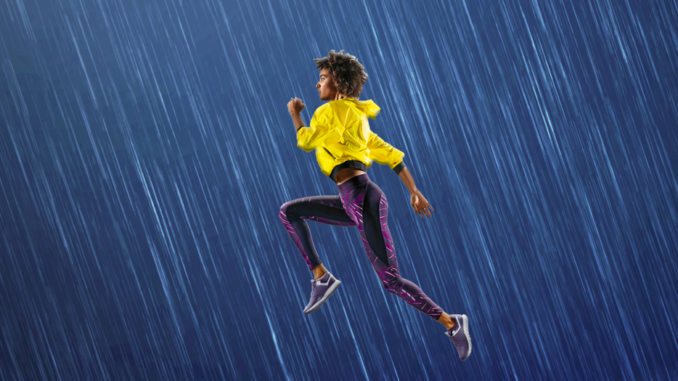
No runner wishes for inclement weather on their training or race day.
Ideally, we’d all be able to train in perfect temperatures with little environmental disturbances. But mother nature is unpredictable and doesn’t abide by our personal wishes.
Running in the rain has its disadvantages but, in many cases, those can be advantageous to you in the long run.
For example, training in inclement weather can help you push past limitations. Whenever you push yourself to withstand cold temperatures, rain, wind, etc., you make yourself stronger. Pain helps us improve and become better than we were.
But running in the rain also comes with taking some extra precautions. Depending on how hard the rain is, you’ll likely have to slow down your pace to prevent slipping or falling. You’ll also have to prepare more beforehand to ensure your run is as comfortable as possible.
Below are a few tips for running in the rain successfully.
Dress In Layers
Rain is often accompanied by lower temperatures. When you’re wet, cooler temperatures feel colder than they are. If you’re going to run in the rain, plan on wearing multiple light layers. Wearing layers while running in the rain will allow you to strip off a few layers if you become too warm or wet.
Wear Waterproof Clothing
Moisture-wicking clothing is your best friend when running in the rain. Clothing layers that repel water as opposed to absorbing them will make your run more comfortable. Make sure your outermost layer is waterproof to keep your other clothing layers dry. Look for light-weight rain jackets that you can easily fit over several layers of clothing.
Keep the Rain Out of Your Face
Running in the rain lowers your visibility, especially when you have torrents of raindrops falling on your face. To increase your visibility and keep the rain out of your face, wear a moisture-wicking hat that will protect your face from being bombarded with raindrops. You could also consider wearing a shower cap underneath to keep your hair dry and prevent it from dripping down into your eyes.
Choose Bright Colors
Running in the rain not only lowers your disability but of other people as well, namely motorists. Wearing bright colors will help you stand out and make it easier for motorists to see you. This is especially important if you run on or alongside a road or major highway. For safety reasons, you want people to be able to see you coming.
Wear Thinner Socks
Your feet will ultimately get wet while running in the rain, even if you avoid puddles. Thick cotton socks will quickly become soggy, wet, and uncomfortable to run in. No one likes that squishy feeling of wet socks under their feet, yuck. To avoid this problem, choose thinner socks meant to repel moisture.
Grab a Pair of Gloves
Wetter running conditions often mean cooler temperatures. If your bare hands are exposed to the elements, they can quickly become cold, which can be very uncomfortable during a run. Grab a pair of gloves before heading out to protect your hands from getting cold. Look for moisture-wicking gloves or gloves that dry quickly. Running with soggy gloved hands will be just as uncomfortable as running without them.
Leave Electronics At Home
Consider leaving your electronics at home when running in the rain to protect them from water damage. If they are not waterproof, then you risk ruining them. However, if you can’t run without your electronic devices, protect them by putting them inside a plastic bag. Make sure the plastic bag is sealed tight to prevent any water leakage from seeping through.
Running in the Rain Aftercare
Running in the rain presents a few different challenges you wouldn’t need to consider post-run in more favorable weather conditions. Below are a few tips for taking care of yourself and your running gear after running in the rain.
Strip Off Wet Clothes Immediately
Hanging out in your wet clothes post rainy run is not only uncomfortable, but it could be unhealthy. When you’re wet in cooler temperatures, you risk catching a chill and coming down with a cold. And for ladies, wearing wet underpants or pants for a period can disrupt the PH balance “down there” and potentially cause a yeast infection. To prevent this, change into dry clothes as soon as you can.
Keep Your Shoes Dry
Your running shoes are your most important running gear. You should protect them as much as you can to prevent damage or warping from the moisture. Take off your shoes and dry them out as soon as you finish your run. Take the soles out from the bottom to dry separately, so they dry more quickly. Then, stick newspaper inside your shoes to absorb the moisture. Whatever you do, don’t put your shoes in a drying machine. Drying machines can damage and warp your running shoes.
Take Care Of Your Feet
Running in the rain leads to cold, wet feet. It’s essential to take care of your feet as soon as you get home to prevent blisters and fungus. Dry your feet once you take your shoes off and do any necessary TLC (bandages, blister cream, etc.). Don a pair of warm, dry socks and let them relax after your tough training run.
Should You Run in the Rain?
Running in the rain is perfectly fine if you run prepared and consider your safety.
Extreme conditions like heavy rain, harsh wind, or thunder and lightning are not safe conditions to run in. Wait for the storm to blow over or opt to run on a treadmill.
Light rain, drizzle, or warm rain conditions are usually fine if you’re prepared. Running in the rain can make you more resilient as a runner and better prepared for your next race.
Just make sure you are taking the proper precautions and taking care of yourself post-run.



